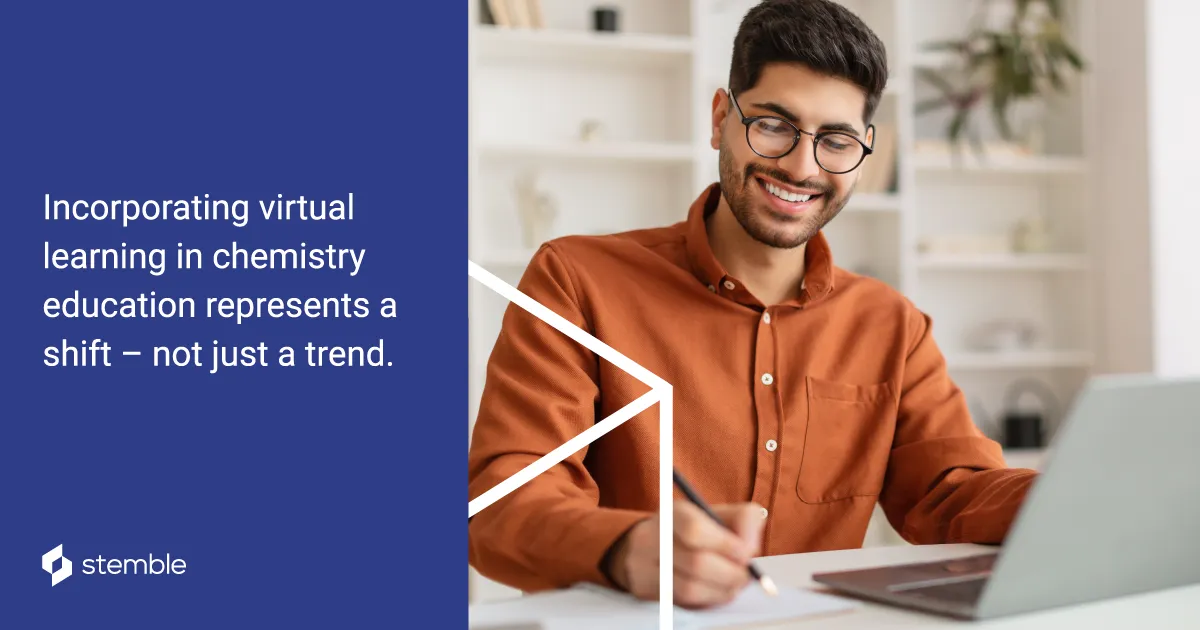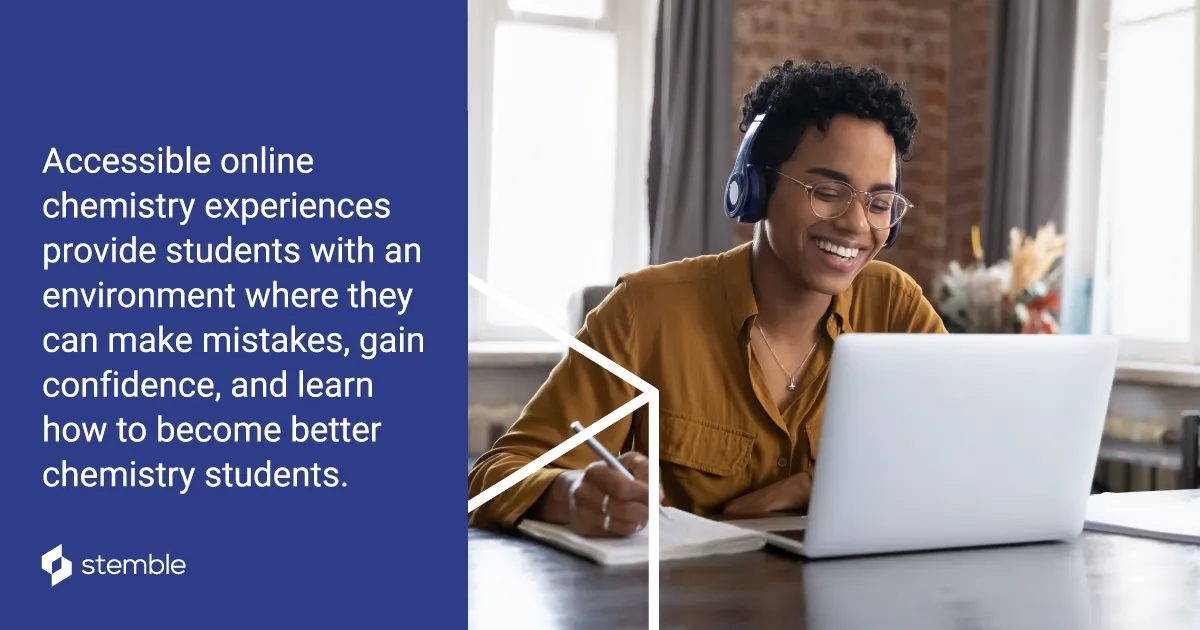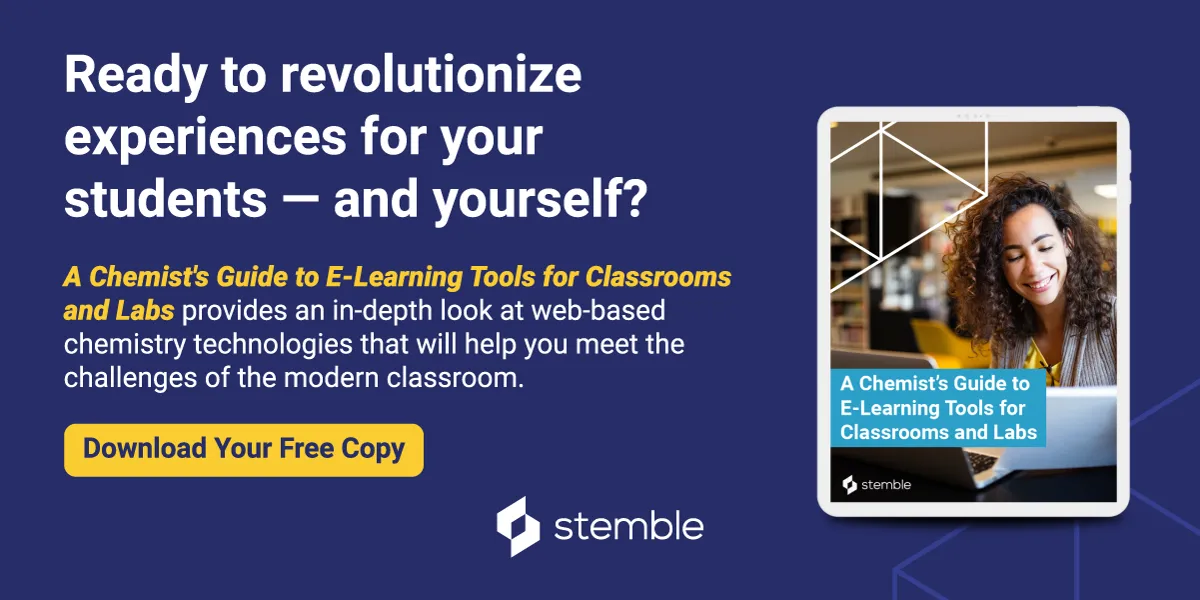Research in Education
How a Digitally Accessible Online Chemistry Experience Improves Student Outcomes in Science Education
A digitally accessible online chemistry experience improves student outcomes in science education, especially when paired with a traditional chem lab.
Prof. Jason Pearson, PhD

When we think of early college chemistry education, two things may come to mind: packed lecture halls filled with glazed-eyed students and chaotic chem labs of students struggling to figure out what they’re doing while a TA tries to be sure they’re safe. But, have you ever considered how a digitally accessible, online chemistry experience could help change those stereotypes for the better — and improve student outcomes at the same time?
We see a lot of lab programs and departments across North America that are really outsiders when it comes to technology. It’s not that surprising because we’ve “always” taught chemistry in lectures and live labs. However, educators who embrace technology find that it’s really the best way to engage students.
Virtual labs and other online chemistry experiences are the way of the future. They help prepare students and provide them with chemistry education wherever they are.

What Is an Online Chemistry Experience?
When you hear “virtual lab” and “online chemistry experience” or “chemistry simulation,” you may wonder how it can be more accessible than traditional, in-person (or online lecture) chemistry education. The most cutting-edge virtual chem programs include realistic, 3D chemistry lab simulations, online resources, and teaching videos for students and can allow students to take tests and complete assignments. In addition to providing virtual labs, some online chemistry solutions (like Stemble) empower educators to focus more on students thanks to real-time analytics and automated repeatable actions like grading exams.
“Regular” chem labs are traditionally hands-on and low-tech — the stock photo images of people just pouring stuff into beakers isn’t always that far off base. That’s why it makes sense to supplement all of that with a technological solution. Incorporating virtual learning in chemistry education represents a shift — not just a trend.
When used together, chemistry is genuinely more accessible to students in every way.
At Stemble, we’re convinced — and our current customers are convinced — that integrating online chemistry simulations with live and in-person experiences is the way of the future, both to prepare students and to assess them afterward.
How Digitally Accessible Can an Online Chemistry Experience Be?
When we talk about accessibility, it’s essential not only to ensure that the experience adheres to accessibility standards but to take “accessibility” even further so every student can have the full benefits of an online platform to learn chemistry. This is where digital accessibility is truly important.
A top-notch online chemistry platform has to meet students where they are. It must be easy to use, available on any device, and be affordable. People shouldn’t need a gaming PC to use it. Students should be able to head to the library and log in or access it from their laptop while they’re not physically on campus. A student could complete chemistry simulations on their phone while riding the bus to school. Meeting students anywhere also means that students in any location will use these tools, including those in remote locations who don’t have access to laboratory services.
At Stemble, we put a lot of work into our platform to ensure that it adheres to accessibility standards and doesn’t require any special software. It’s “just” a web app that’s super easy for people to use from a web browser. It’s lightweight enough to be used on a phone, as the amount of data transfer that happens as a student uses these simulations is minimal, allowing students to work on their education from anywhere.
Tools that don’t need anything special are crucial to student engagement and success. And we know that students value being able to use the technology they already own, maximizing the usefulness of the devices they carry every day.
Today’s students have plenty of challenges, and accessing their schoolwork, including chemistry, shouldn’t be one of them! That’s critical, because if you’re going to attach grades to an online component, your entire class needs to have access to it.
How an Online Chem Program Improves Student Outcomes
Preparing Students for Live Labs
One of the most significant issues that lab staff and teaching staff consistently note is concern about a lack of preparation on the part of their students.
Unprepared students cause plenty of problems, particularly all kinds of safety issues and delays in the actual lab. Correcting all those is a big time-sink for educators — though far from the only one. So, an online chemistry experience that is easily accessible allows you to deploy experiences to prepare students for the in-person lab, and attaching grades to those experiences means that students will actually do them.
Chemistry can be intimidating for some students, and preparing for labs can be a big challenge. Fortunately, we often hear stories from students who have used an online chemistry simulation to gain the confidence they needed in the safest possible place.
Keeping It Real
High-quality virtual labs will offer virtual lab simulations that are three-dimensional. It’s analogous to a virtual reality experience but one that you can do on your laptop, or your phone. (For our product, Stemble, this was a very careful choice because we wanted it to be as realistic as possible.) Neither the science nor the process is dumbed down, and you can translate that experience to the real world.
A realistic simulation will engage students — but the benefits of a simulation are still key. Students can fail, even spectacularly, and roll back the simulation to better understand what happened. That, and speeding up an experiment, are things that students can’t do in a live chem lab.
Realism is important because when students get in the lab, they learn how things work in real life, which they’ll use to achieve better results.
Breaking Down Fears
Chemistry can be intimidating for those totally unfamiliar with the study or lab procedures. Students also frequently come with misconceptions about chemistry. Realistic labs help break down fear barriers, making chemistry more approachable for all students. This is probably the most beneficial accomplishment of an online chem program.
In one university-wide survey at a school that uses an integrated live and online chemistry program, chemistry students were asked the most beneficial part of their course. Many cited how access to virtual lab and chemistry assignments positively impacted their approach to chemistry and overall experience.
Some students expressed being nervous about lab work. One wrote, “So, I was really afraid to go into this lab and start doing things…” But, with a virtual lab providing total freedom to fail safely, the student realized they could approach chemistry and be successful. “I could go in and really work out what all the details were of the experiment — what I was being asked to do, and what I was going to have to do when I got there. And, you know, I was that much more confident when I went in there!”
Some students even reported that the online tool is their favorite part of the class; “I don’t have to be afraid to make mistakes and lose points. I can try them again and use the given hints that help me learn the most.”
These kinds of online chemistry experiences allow you to deploy activities that prepare students for the in-person lab — preparation students both need and want.
.
Benefits of Online Tools for Chemistry
You need students to do their homework in order to come to class prepared. At the same time, there’s nothing worse for a student than being given work they feel is meaningless. You know it’s not meaningless, but students don’t always see it that way.
However, integrating online chemistry experiences with your in-person learning can help.
First, it’s no surprise that students are more likely to complete assignments if you attach a grade to those assignments. However, correcting those assigned problems and grading all of the assignments and lab reports from hundreds of students afterward is not something most educators have time for. And grading staff, such as graduate students, would prefer to be in their research labs over grading papers. An online system can automatically assess and even grade those assignments, removing hours of tedious grading from an educator’s schedule so they can focus on student learning and outcomes rather than paperwork.
A campus technology survey by independent research firm Survata in 2017 indicated that 94% of students wanted to use their cell phones to access class materials and participate in discussions. There’s no need to discourage students from engaging when they want to when there are tools designed to meet students where they are.
Second, students can improve their results by getting automatic feedback based on their performance on assignments and in the virtual lab because that’s what the platform handles. Providing students with timely feedback and understanding the support they need is essential for good outcomes. In addition to providing lessons and simulations, automatic grading frees up faculty and TAs to be more available for students.
Additionally, a virtual chemistry program will always be there for students, no matter what happens.
For example, one of our clients is a lab coordinator who integrated their chemistry course with an online option. They had a fairly significant accident that put them out of commission right when all grades were due at the end of the semester. At a time when there is usually a lot of back and forth between students and staff to argue for grades, Stemble allowed for clear and transparent communication with all students regarding what their lab grades were and why. While the lab coordinator was unavailable, the interim coordinator was able to use the data and records of student activity captured from the online chemistry lab platform to have all grades submitted on time.
An online chemistry experience that is digitally accessible solves all of those problems and allows you to deploy experiences to prepare students for the in-person lab. And it is absolutely the future.
Backed Up By Real-World Data
It’s unusual to get complete agreement on any topic, and we found it helpful to hear that 100% of students report being incentivized by grades. So when every single student in the group says that they are motivated by grades, it’s a clear indication that they’re likely to be extrinsically motivated to use a tool that will improve grades.
By attaching a grade to lab preparation, for example, with a simulation activity, students are motivated to complete it. And with the prospect of a grade and easy access to content on their devices whenever they want, students will do the work.
But the grade isn’t the end goal — the end goal is students who are prepared for their in-person labs and who act safely and efficiently in the lab environment. We’ve also carefully watched usage statistics on our virtual chemistry platform. We’ve seen classes where 100% of students complete their preparation exercises.
We know that we can leverage online scenarios to engage students and provide both extrinsic and intrinsic motivation that encourages all students to actually do the preparatory work. These results felt pretty remarkable to us both as scientists and educators!
In follow-ups with chemistry faculty who have used an online chemistry platform, we’ve asked their feelings on student performance over the course of a year. The faculty reported that students appeared to work more quickly in the lab. In some cases, educators suggested that they reduced the time they needed to be in the lab by 25% — what took students four hours last year took only three after working with Stemble’s online chemistry tools. And faculty report that students are more prepared and behave more safely in the lab, both of which lead to stronger outcomes.
In a 2018 Journal of Chemical Education article, Online Prelaboratory Videos Improve Student Performance in the General Chemistry Laboratory, researchers reported that, “Students were more efficient and demonstrated a greater understanding of the rationale for procedures for the two laboratory activities that used online prelaboratory videos than those that used prelaboratory lectures.” They concluded that, “Online prelecture videos have significant potential for improving student learning in the general chemistry laboratory and for reducing demand on institutional resources for associated courses.”
And in an age where people can track real-time traffic while driving, video chat at a moment’s notice, and play AR games on their phones, there are no excuses for accessibility barriers. Nor are there reasons that students should not be empowered to understand chemistry in a well-supported online environment to improve their real-world experiences. Fortunately, online chemistry experiences provide students with an environment where they can make mistakes, gain confidence, and learn how to become better chemistry students.

Prof. Jason Pearson, PhD
Co-Founder
Jason Pearson is a Professor of Chemistry at the University of Prince Edward Island, where he leads an interdisciplinary research group in computational methods for chemistry. He is also co-founder of Stemble Learning, a data-driven teaching and learning platform for chemistry classes and laboratories. He is the winner of numerous SoTL awards including the Reg Friesen Award from the Chem. Ed. Division of the CSC, The Hessian Award, The Janet Pottie Murray Award for Educational Leadership, and the Brightspace Award for Innovation in Teaching and Learning from the STLHE.
